When we humans have many different types of relationships in our life. While having these relations may seem good for our existence and survival, one reason can turn these relationships into suffering. That is an attachment.
Though attachment is the building block of relationships, it is this attachment that can make relationships a suffering for us as well.
There are a lot of different types of attachment disorders. In this article, we are going to cover anxious attachments and will explore how meditation can help us.
If you’re struggling with anxious attachment, you might be interested in exploring meditation as a way to help manage your symptoms. There are different meditation for anxious attachment that can prove to be beneficial. Read on to find which meditation can be helpful for anxious attachment.
What Is Anxious Attachment
An anxious attachment is a type of attachment style characterized by anxious, clingy, and needy behavior. People with anxious attachments tend to be fearful of rejection and abandonment, and as a result, they often go to great lengths to stay close to their loved ones. They may be possessive and jealous, and they may constantly seek reassurance that they are loved.
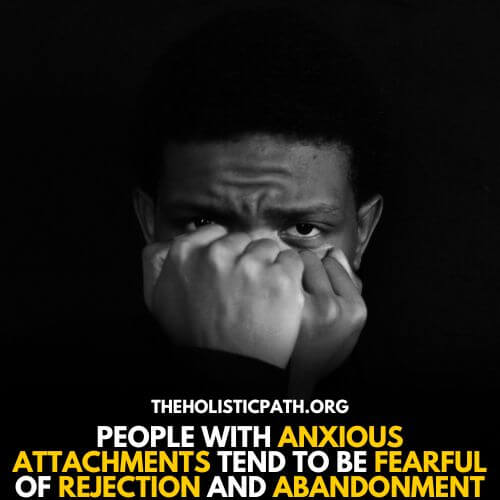
Anxious attachments can develop in response to early experiences of insecurity or upheaval, making it difficult for people to maintain healthy relationships. If you think you might have an anxious attachment, it’s important to seek out help from a trusted therapist or counselor who can help you explore your fears and learn healthy coping skills.
Types Of Anxious Attachments
Anxious attachment is a type of attachment style that can develop in children who have anxious or insecure attachment styles. There are four different types of anxious attachment:
- Anxious-ambivalent
- Anxious-avoidant
- Anxious-preoccupied
- Anxious-resistant
Each type is characterized by different behaviors and reactions to relationships. For example, people with an anxious-ambivalent attachment may be clingy and need constant reassurance, while those with an anxious-avoidant attachment may avoid intimacy and close relationships.
People with an anxious-preoccupied attachment may be constantly worried about being abandoned, and those with an anxious-resistant attachment may swing between wanting closeness and distance in a relationship. While each type of anxious attachment has its own unique symptoms, all four types share a common underlying cause: a fear of abandonment.
This fear can lead to feelings of insecurity, anxiety, and mistrust in relationships. While it is not always possible to change your attachment style, there are some things you can do to help manage your anxiety, such as meditation and therapy.
How Does Meditation Helps With Anxious Attachment
Anxious attachment is a type of attachment style characterized by worry, neediness, and a strong desire for connection. If you have an anxious attachment, you may find yourself feeling anxious and clingy in relationships, always worrying that your partner will leave you.
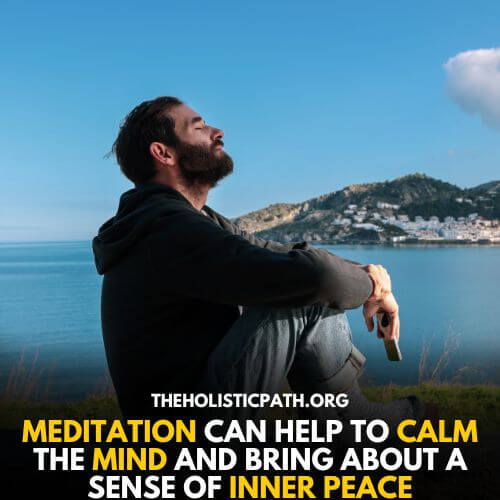
While this can be tough to deal with, meditation can be a helpful tool for managing anxious attachment. Meditation can help to calm the mind and bring about a sense of inner peace.
It can also help to increase focus and concentration, two things that can be very helpful when dealing with anxious attachment.
If you’re struggling with anxious attachment, give meditation a try. It just might help you to find some peace and calm in your life.
Benefits of meditation for anxious attachment
While anxious attachment can be difficult to deal with, meditation can be a helpful tool for managing anxious thoughts and emotions. Here are 15 benefits of using meditation for anxious attachment:
- Meditation can help to calm the mind and body, providing relief from anxious thoughts and worry.
- It can help to increase self-awareness, allowing you to better understand your anxious thoughts and triggers.
- Meditation can help to reduce stress and anxiety levels, making it easier to cope with anxious thoughts and situations.
- It can improve sleep quality, as anxious thoughts can often cause insomnia.
- Meditation can boost your mood and overall sense of well-being, helping to offset the negative effects of anxious thoughts.
- It can increase your focus and concentration, making it easier to pay attention to tasks at hand despite anxious thoughts.
- It can improve your memory by reducing the intrusive effects of anxiety on memory recall.
- Meditation can help you to develop healthy coping mechanisms for dealing with anxious thoughts and feelings.
- It can increase your resilience in the face of stress, making it easier to manage anxious situations without becoming overwhelmed.
- It can teach you how to control your breathing, which can help to ease anxiety and promote relaxation.
- Meditation supports positive thinking, helping you to counter negative thought patterns associated with anxiety disorders.
- It helps you to become more accepting of yourself, which can reduce the obsessive thinking that often accompanies anxious attachment disorder.
- It provides a sense of detachment from anxious thoughts, helping you to observe them without getting swept up in them emotionally.
- It fosters a greater sense of self-compassion, which is essential for managing anxiety in a healthy way.
- It gives you a break from the non-stop chatter of your mind, providing much-needed respite from anxious thoughts.
Meditation For Anxious Attachment
There are many different types of meditation, and it can be tough to know which one is right for you. If you suffer from anxious attachment, you may find that certain types of meditation are more helpful than others.
Here are a few to try:
1. Mindfulness Meditation:
Anxious attachment is a condition that can cause people to feel insecure in their relationships and constantly seek approval from others. Mindfulness meditation is a type of meditation that can help people with anxious attachments learn to focus on the present moment and let go of their negative thoughts and emotions.
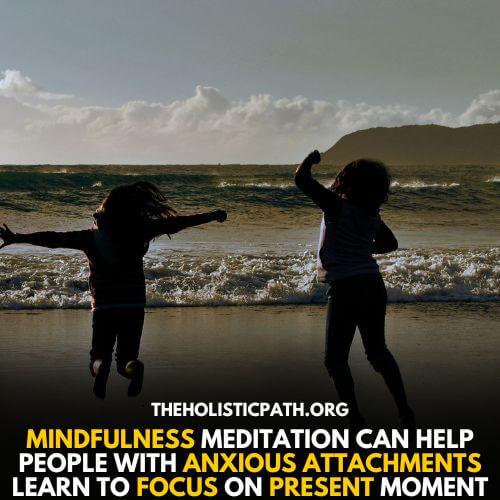
Some benefits of mindfulness meditation include:
- improved mood
- reduced anxiety
- increased self-awareness
- improved relationships
Practicing mindfulness meditation can help people with anxious attachment learn to control their thoughts and emotions, and eventually lead to a more balanced and healthy lifestyle.
How To Practice Mindfulness Meditation:
To practice mindfulness meditation, find a comfortable place to sit or lie down. Close your eyes and take a few deep breaths. Then, begin to focus on your breath.
Notice the sensation of the air moving in and out of your lungs. Observe your thoughts without judging them or getting caught up in them. If your mind begins to wander, simply refocus on your breath. Continue for 10-15 minutes.
2. Loving-Kindness Meditation:
Loving-kindness meditation is a type of mindfulness meditation that involves focusing on feelings of kindness and compassion. The goal is to cultivate positive emotions towards oneself and others.
This can help to counterbalance the negative feelings associated with anxious attachment. Additionally, the regular practice of loving-kindness meditation has been shown to reduce stress and anxiety levels, as well as improve mood and well-being.
If you’re struggling with anxious attachment, give loving-kindness meditation a try. It just might help you find more peace and calm in your life.
How To Practice Loving-Kindness Meditation:
One way to help ease your anxious feelings is through the practice of loving-kindness meditation. Doing this type of meditation can help you to develop a more compassionate and accepting attitude towards yourself, which can in turn help to lessen your anxiety. Here’s how to get started:
- Sit in a comfortable position and close your eyes.
- Take a few deep breaths and focus on the sensation of your breath moving in and out.
- Once you’ve settled into a rhythm, begin repeating the following phrases (or ones similar) to yourself: “May I be happy. May I be healthy. May I be safe. May I live with ease.”
- Allow yourself to really feel the meaning of these words as you say them.
- If your mind wanders, simply bring it back to focusing on the breath and repeating the phrases.
Doing this meditation for even just a few minutes each day can make a big difference in how you relate to yourself—with much more kindness, understanding, and love.
3. Body-Scan Meditation:
Anxious attachment is a type of attachment style that can cause people to feel anxious and worried in their relationships. Body-scan meditation can be a helpful tool for dealing with this type of attachment. This type of meditation involves focusing on the body and breathing, which can help to calm the mind and reduce anxiety.
The practice of body-scan meditation can also help to increase awareness of the body and its sensations, which can be helpful in dealing with anxious attachment. In addition, body-scan meditation can help to increase self-compassion and acceptance, which are important for managing anxious attachment.
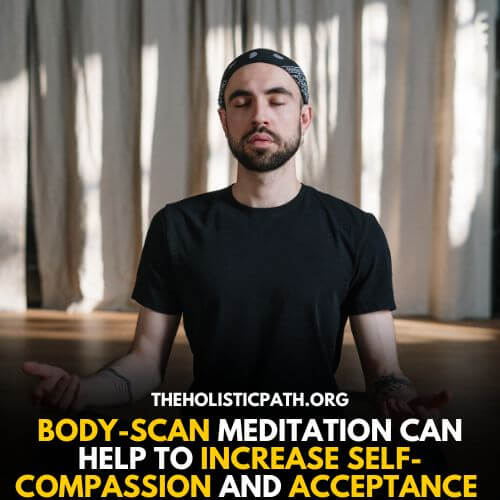
How To Practice Body-Scan Meditation:
Body scan meditation involves focusing your attention on each part of your body, from your toes to your head. As you focus on each part of your body, notice any sensations or emotions that arise. Allow yourself to simply observe these sensations without judgment. The goal is not to change or eliminate any sensations, but simply to become more aware of them.
Body scan meditation can help to ease anxious attachment by helping you to become more aware of your body and its sensations. This can help you to better understand and regulate your emotions, which can in turn improve your relationships.
Here’s how to do a body scan meditation:
- First, find a comfortable place to sit or lie down. You can do this meditation seated in a chair with your feet flat on the ground, or lying down on your back with your legs extended.
- Close your eyes and take a few deep breaths.
- Once you’re feeling relaxed, begin to focus your attention on your breath. Notice the sensation of the air moving in and out of your lungs.
- From there, begin to focus your attention on different parts of your body, starting with your toes and moving up to your head. Notice any sensations that you feel in each part of your body– whether it’s tightness, tingling, warmth, or something else.
- Don’t judge the sensations that you feel– just observe them without judgment.
- Continue moving through different parts of your body until you’ve reached your head. Then, take a few deep breaths and slowly open your eyes when you’re ready.
Regular practice of body scan meditation can help ease anxious attachment by increasing awareness of the physical sensations in your body. This can help you to feel more grounded and present in the moment, which can lessen the worry and anxiety that accompanies anxious attachment.
4. Transcendental Meditation:
Transcendental meditation is a form of meditation that helps people to relax and focus their minds. There are many benefits to transcendental meditation, including reducing anxiety and improving mental well-being.
One of the ways in which transcendental meditation can help with anxious attachment is by promoting feelings of calm and relaxation. When people are feeling anxious, they often meditate to help themselves feel better.
Transcendental meditation can also help to reduce stress levels and improve sleep quality. This is because when people meditate, they are able to clear their minds and focus on the present moment. This can help to ease anxiety and promote a sense of well-being. Ultimately, transcendental meditation can be an effective way to deal with anxious attachment.
How To Practice Transcendental Meditation:
Transcendental meditation is one way to help deal with these issues. TM is a type of meditation that involves repeating a mantra or sound to yourself. It can be done for 20 minutes twice a day.
Here’s how to do TM:
- Sit with your spine straight in a comfortable position.
- Close your eyes and begin to focus on your breath.
- Once you have settled into a rhythm, begin repeating the mantra or sound to yourself.
- Don’t worry if your mind wanders at first – just keep coming back to the mantra or sound.
- After 20 minutes, open your eyes and get up slowly.
TM can help to calm the mind and reduce stress levels, which can be helpful for those with anxious attachments.
5. Visualization Meditation:
When someone has an anxious attachment, they tend to feel a sense of fear and insecurity in their relationships. This can lead to a lot of stress and anxiety. One way to help manage this anxiety is through visualization meditation.
This type of meditation involves picturing yourself in a calm and peaceful setting. This can help to ease anxious thoughts and feelings. Additionally, it can help to focus on the positive aspects of the relationship. Visualization meditation can be a helpful tool for managing anxious attachment and helping to create a more positive outlook.
How To Practice Visualization meditation:
If you have anxiety around attachment, visualization meditation can be a helpful tool for managing it. Here’s how to do it:
- Sit or lie down in a comfortable position and close your eyes.
- Take a few deep breaths and allow your body to relax.
- Visualize yourself in a safe place. This could be anywhere that makes you feel calm and relaxed.
- Picture yourself surrounded by people who love and support you.
- Imagine the anxiety melting away from your body.
- Stay in this safe space for as long as you need, then slowly open your eyes and return to the present moment.
Dangers of not practicing meditation for anxious attachment
When we don’t practice meditation for anxious attachment, we are essentially allowing our anxiety to take control of us. This can lead to a number of dangerous behaviors, such as:
- Overextending ourselves in relationships in order to gain approval.
- Isolating ourselves from others out of fear of rejection.
- Constantly seeking reassurance from others.
- Engaging in self-destructive behaviors in an attempt to numb our pain.
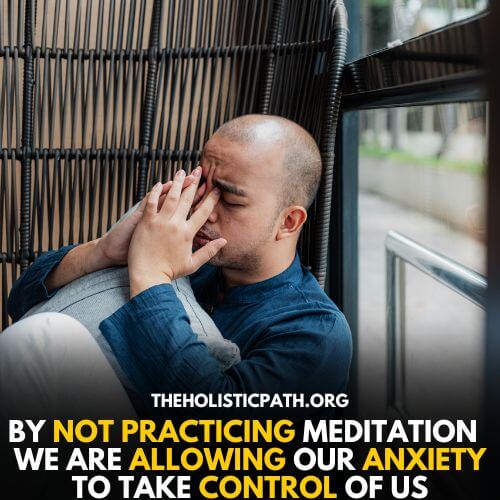
These are just some of the dangers that come with not practicing meditation for anxious attachment. By not taking the time to calm our fears and ease our anxiety, we are putting ourselves at risk in a number of ways. If you find yourself struggling with anxious attachment, please reach out for help and start meditating today. It could save your life.
Tips For Maintaining A Regular Practice Of Meditation Of Anxious Attachment
If you’re someone who struggles with anxious attachment, you may find it helpful to meditate on a regular basis. Here are a few tips to help you get started:
- Choose a time of day when you’re likely to be relatively calm and free from distractions.
- Choose a quiet, comfortable spot where you won’t be disturbed.
- Sit or lie down in a position that’s comfortable for you.
- Close your eyes and focus on your breath.
- Notice the thoughts that come into your mind, but don’t get attached to them. Simply let them go and return your focus to your breath.
If your mind starts to wander, that’s okay – just gently bring your attention back to your breath. With practice, you’ll find it easier and more enjoyable to meditate regularly.
Meditation doesn’t have to be long – even a few minutes can be helpful. Practice regularly, and you’ll start to see the benefits.
Conclusion
Meditation can be a helpful tool for those struggling with anxious attachment. By teaching people to focus on the present moment and to observe their thoughts without judgment, meditation can help to break the cycle of anxiety and rumination. In addition, meditation can help to build emotional resilience and to cultivate a more accepting attitude towards oneself.
However, it is important to remember that meditation is only one part of a larger journey toward healing. Attachment anxiety is a complex issue, and recovery requires time, patience, and self-compassion.
